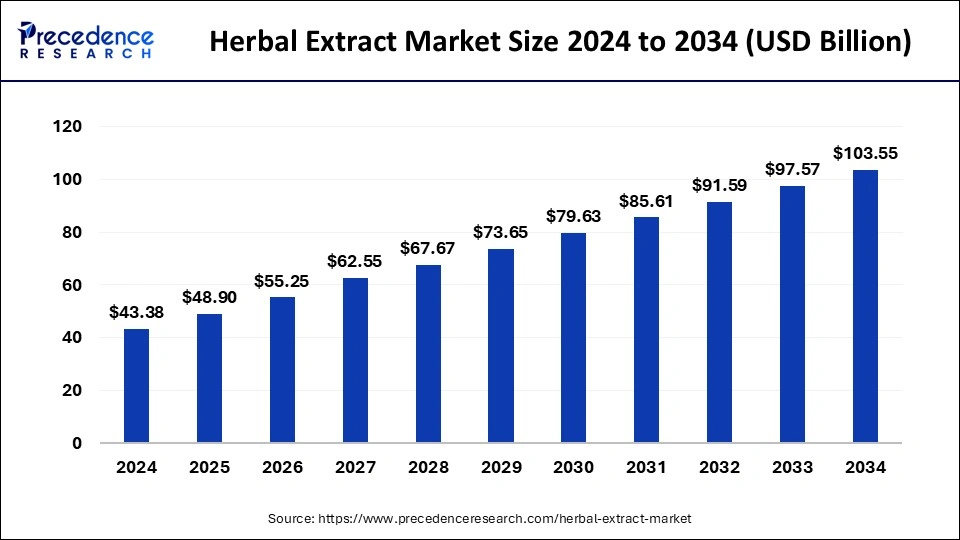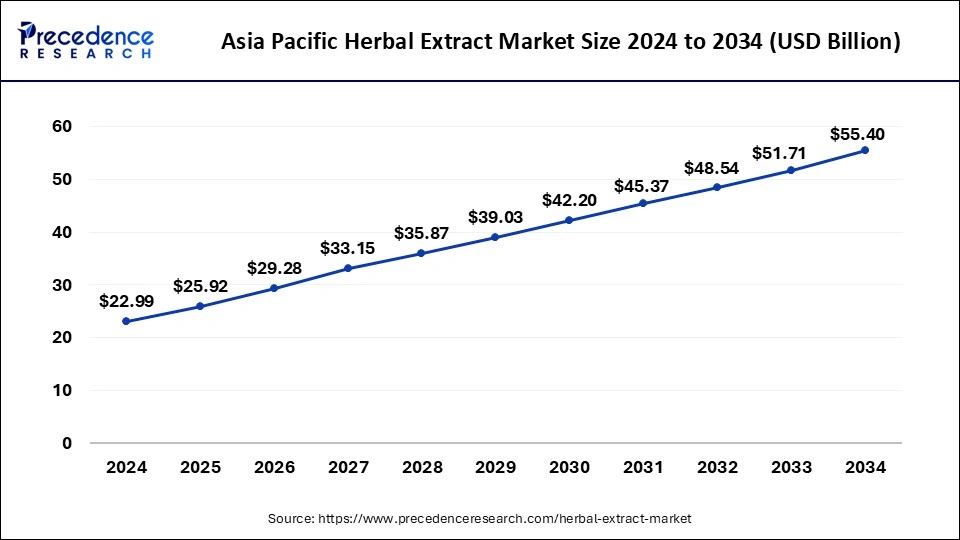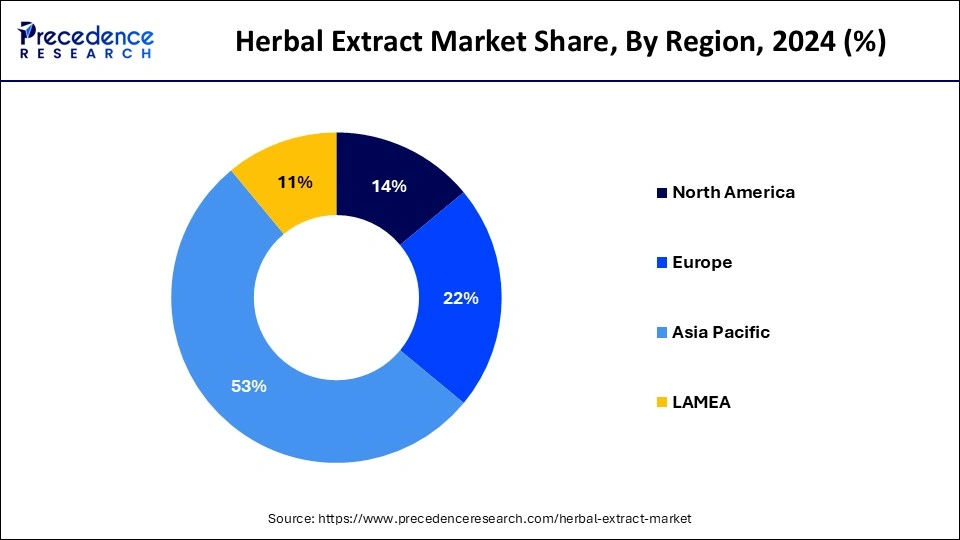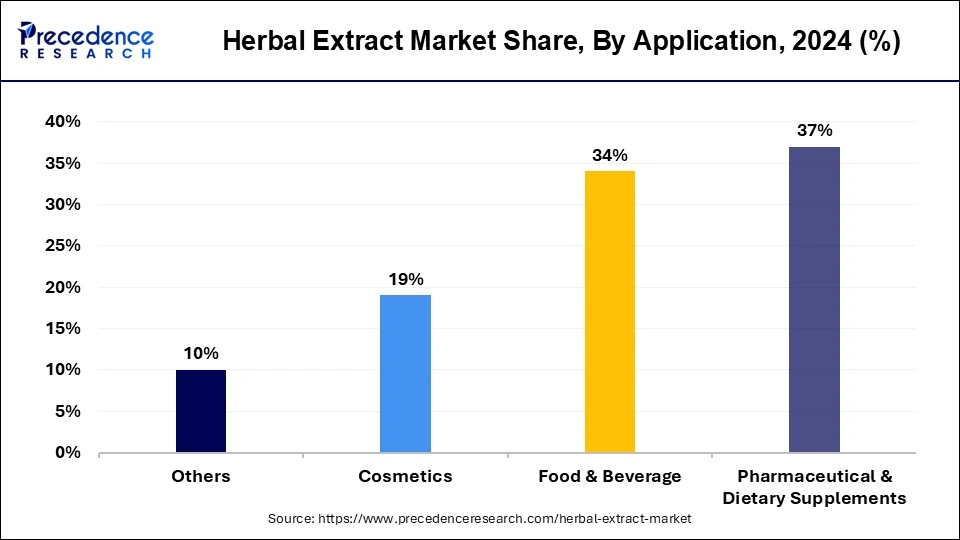April 2025
The global herbal extract market size accounted for USD 48.90 billion in 2025 and is forecasted to hit around USD 103.55 billion by 2034, representing a CAGR of 8.69% from 2025 to 2034. The Asia Pacific market size was estimated at USD 22.99 billion in 2024 and is expanding at a CAGR of 8.81% during the forecast period. The market sizing and forecasts are revenue-based (USD Million/Billion), with 2024 as the base year.
The global herbal extract market size was calculated at USD 43.38 billion in 2024 and is predicted to increase from USD 48.90 billion in 2025 to approximately USD 103.55 billion by 2034, expanding at a CAGR of 8.69% from 2025 to 2034.

The Asia Pacific herbal extract market size was exhibited at USD 22.99 billion in 2024 and is projected to be worth around USD 55.40 billion by 2034, growing at a CAGR of 8.81% from 2025 to 2034.

Asia Pacific held a significant share of the market in 2024; the region is expected to sustain its position during the forecast period. Asia Pacific carries a diverse range of plant species with medicinal properties. Countries such as China, India, Japan, and South Korea have a long history of traditional medicine practices that utilize herbal extracts. These countries also carry knowledge and expertise in identifying, cultivating, and processing medicinal plants, giving them a competitive advantage in the herbal extract market.
Some countries in the Asia Pacific have favorable policies that support the herbal extract industry. For instance, China has a well-established system for registering and regulating traditional Chinese medicine products, including herbal extracts. Such regulatory frameworks provide a conducive environment for the growth and development of the herbal extract market.

The region's dominance in the herbal extract market is driven by its ability to meet the increasing demand from international buyers. Countries like China and India have well-established export networks and robust trade systems with countries around the world, allowing them to capture a significant share of the global herbal extract market.
According to the report published by Pharmabiz in 2022, the exports of herbal products from India increased by 41.5% in the last five years. The Ministry of Ayush, India, is adopting the standardization and certification of herbal pharmaceutical products according to the guidelines of the World Health Organization (WHO); this element is observed to offer a global expansion for herbal products from India while driving the growth of the market.
North America is another fastest-growing region in the herbal extract market; North America is actively involved in research and innovation related to herbal extracts. Academic institutions, research organizations, and companies in the region are conducting studies on herbal extracts' medicinal properties, efficacy, and safety. These research efforts contribute to the development of new and improved herbal extracts, further strengthening the region's position in the market.
The herbal extract market refers to the industry that revolves around the extraction, processing, and commercialization of bioactive compounds obtained from plants for multiple applications. Herbal extracts are concentrated forms of plant materials that contain beneficial compounds, such as phytochemicals, flavonoids, alkaloids, and essential oils. These extracts are obtained through various extraction methods, including solvent extraction, distillation, cold pressing, and supercritical fluid extraction.
Herbal extracts have applications in diverse industries, including pharmaceuticals, cosmetics, food and beverages, dietary supplements, and aromatherapy. They are used for their potential health benefits, flavoring properties, fragrance, and therapeutic applications. The herbal extract market encompasses manufacturers, suppliers, distributors, and end-users who are involved in the production and utilization of these extracts.
The herbal extract market is experiencing significant growth due to several key factors. Firstly, there is an increasing global demand for natural and plant-based products, driven by the growing awareness of health and wellness. Consumers are seeking alternatives to synthetic ingredients and are showing a greater interest in traditional and herbal remedies. Secondly, there is a surge in research and development activities focused on herbal extracts, leading to innovations in extraction techniques, formulation methods, and product development.
Additionally, favorable regulatory frameworks in many countries are supporting market growth by ensuring safety, quality, and efficacy standards. The market is also benefiting from advancements in technology, such as improved extraction methods and analytical techniques, which enhance the quality and consistency of herbal extracts.
Furthermore, the strong tradition of herbal medicine in many cultures, coupled with increased consumer trust and acceptance, is driving the market forward. Overall, these growth factors are propelling the herbal extract market and opening up new opportunities for manufacturers, suppliers, and consumers alike.
| Report Coverage | Details |
| Market Size in 2025 | USD 48.90 Billion |
| Market Size by 2034 | USD 103.55 Billion |
| Growth Rate from 2025 to 2034 | CAGR of 8.69% |
| Largest Market | Asia Pacific |
| Fastest Growing Market | North America |
| Base Year | 2024 |
| Forecast Period | 2025 to 2034 |
| Segments Covered | Type, Source and Application |
| Regions Covered | North America, Europe, Asia-Pacific, Latin America, and Middle East & Africa |
Rising utilization from the nutrition industry
The rising utilization of herbal extracts in the nutrition industry is driven by consumer demand for natural and functional ingredients, the growth of nutraceuticals and functional foods, the clean labeling movement, scientific research supporting health claims, and the trend toward customization and personalization. Herbal extracts, derived from plant sources, are seen as natural ingredients that align with clean labeling trends. The nutrition industry is responding to this demand by incorporating herbal extracts as natural flavorings, colorants, and functional ingredients in various nutritional products. Extensive scientific research is being conducted to explore the health benefits and mechanisms of action of herbal extracts. This research provides the scientific evidence necessary to support health claims associated with herbal extracts, this element is expected to fuel the growth of the market.
Slower results in the medicinal process
Despite the ability to treat a wide range of illnesses, herbal remedies typically take longer to work than conventional drugs. Conventional pharmaceutical drugs often provide faster symptom relief or targeted therapeutic effects compared to herbal extracts. When receiving herbal treatment, one must possess extreme tolerance. In certain situations, using herbal remedies might result in adverse responses. This slower timeframe for results may deter some consumers who are seeking immediate solutions or quick relief. As a result, the market demand for herbal extracts may be limited.
Rising investments in the research and development activities
Increased investment in research and development activities allows for the exploration of new herbal sources, extraction techniques, and formulation methods. This leads to the development of innovative herbal extract products with enhanced efficacy, improved bioavailability, and targeted applications. Such investments foster the creation of unique offerings, and this opens a plethora of opportunities for the market to grow. Increased investment in R&D enables the exploration of new therapeutic applications for herbal extracts. Researchers can investigate the potential of herbal extracts in addressing specific health conditions, developing new treatments, and discovering novel drug leads. This expands the market opportunities for herbal extracts in pharmaceuticals and healthcare industries.
The Food and Beverages segment dominated the market with the largest share in 2024; the region will continue to grow significantly during the forecast period. The growth of the segment is attributed to the increasing demand for herbal, plant-based, or natural products by consumers. In recent times, consumers preferably choose natural and minimum processed foods in their daily routine. Herbal extract helps to improve the quality of the product and helps to increase its shelf life for more prolonged use, which is expected to increase the use of herbal extract by the food and beverage manufacturer. Growing concern about health and fitness in the consumer will fuel the growth of the herbal extract market in the forecast period.

The personal care and cosmetics segment is expected to grow at a robust pace in the market during the predicted time frame. The growth of the segment is expected to be boosted due to the shifting consumer preferences from synthetic chemical products to herbal products. Herbal extract products do not harm the skin and don’t create other personal hygiene issues.
By Source
By Type
By Application
By Geography
For inquiries regarding discounts, bulk purchases, or customization requests, please contact us at sales@precedenceresearch.com
No cookie-cutter, only authentic analysis – take the 1st step to become a Precedence Research client
April 2025
March 2025